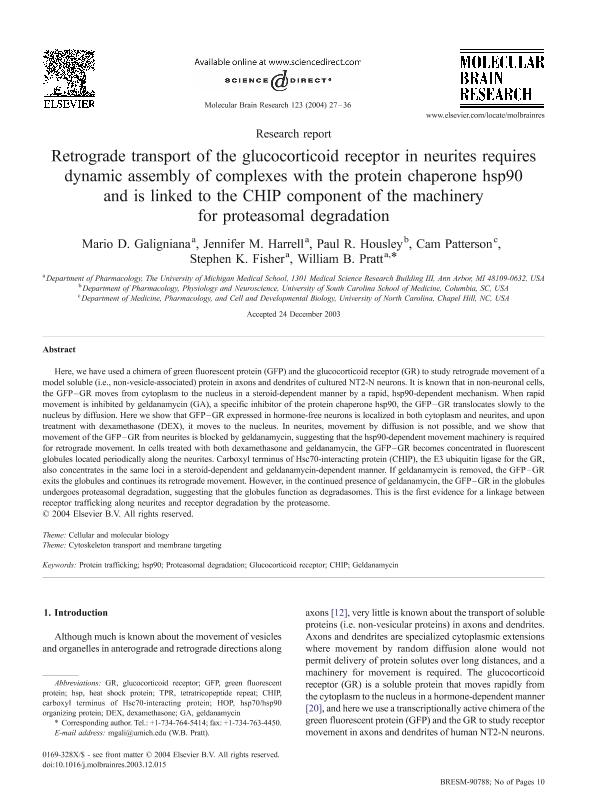Mostrar el registro sencillo del ítem
dc.contributor.author
Galigniana, Mario Daniel

dc.contributor.author
Harrell, Jennifer M.
dc.contributor.author
Housley, Paul R.
dc.contributor.author
Patterson, Cam
dc.contributor.author
Fisher, Stephen K.
dc.contributor.author
Pratt, William B.
dc.date.available
2017-11-25T11:02:38Z
dc.date.issued
2004-12
dc.identifier.citation
Galigniana, Mario Daniel; Harrell, Jennifer M.; Housley, Paul R. ; Patterson, Cam ; Fisher, Stephen K. ; et al.; Retrograde transport of the GR requires dynamic assembly of complexes with hsp90 and is linked to the CHIP component of the proteosome; Elsevier; Molecular Brain Research; 123; 12-2004; 27-36
dc.identifier.issn
0169-328X
dc.identifier.uri
http://hdl.handle.net/11336/29101
dc.description.abstract
Here, we have used a chimera of green fluorescent protein (GFP) and the glucocorticoid receptor (GR) to study retrograde movement of a model soluble (i.e., non-vesicle-associated) protein in axons and dendrites of cultured NT2-N neurons. It is known that in non-neuronal cells, the GFP-GR moves from cytoplasm to the nucleus in a steroid-dependent manner by a rapid, hsp90-dependent mechanism. When rapid movement is inhibited by geldanamycin (GA), a specific inhibitor of the protein chaperone hsp90, the GFP-GR translocates slowly to the nucleus by diffusion. Here we show that GFP-GR expressed in hormone-free neurons is localized in both cytoplasm and neurites, and upon treatment with dexamethasone (DEX), it moves to the nucleus. In neurites, movement by diffusion is not possible, and we show that movement of the GFP-GR from neurites is blocked by geldanamycin, suggesting that the hsp90-dependent movement machinery is required for retrograde movement. In cells treated with both dexamethasone and geldanamycin, the GFP-GR becomes concentrated in fluorescent globules located periodically along the neurites. Carboxyl terminus of Hsc70-interacting protein (CHIP), the E3 ubiquitin ligase for the GR, also concentrates in the same loci in a steroid-dependent and geldanamycin-dependent manner. If geldanamycin is removed, the GFP-GR exits the globules and continues its retrograde movement. However, in the continued presence of geldanamycin, the GFP-GR in the globules undergoes proteasomal degradation, suggesting that the globules function as degradasomes. This is the first evidence for a linkage between receptor trafficking along neurites and receptor degradation by the proteasome.
dc.format
application/pdf
dc.language.iso
eng
dc.publisher
Elsevier

dc.rights
info:eu-repo/semantics/openAccess
dc.rights.uri
https://creativecommons.org/licenses/by-nc-nd/2.5/ar/
dc.subject
Protein Trafficking
dc.subject
Hsp90
dc.subject
Proteasomal Degradation
dc.subject
Glucocorticoid Receptor
dc.subject
Chip
dc.subject
Geldanamycin
dc.subject
Neuronal Cells
dc.subject.classification
Bioquímica y Biología Molecular

dc.subject.classification
Medicina Básica

dc.subject.classification
CIENCIAS MÉDICAS Y DE LA SALUD

dc.title
Retrograde transport of the GR requires dynamic assembly of complexes with hsp90 and is linked to the CHIP component of the proteosome
dc.type
info:eu-repo/semantics/article
dc.type
info:ar-repo/semantics/artículo
dc.type
info:eu-repo/semantics/publishedVersion
dc.date.updated
2017-11-16T15:12:15Z
dc.journal.volume
123
dc.journal.pagination
27-36
dc.journal.pais
Países Bajos

dc.journal.ciudad
Amsterdam
dc.description.fil
Fil: Galigniana, Mario Daniel. University of Michigan; Estados Unidos. Consejo Nacional de Investigaciones Científicas y Técnicas; Argentina
dc.description.fil
Fil: Harrell, Jennifer M.. University of Michigan; Estados Unidos
dc.description.fil
Fil: Housley, Paul R.. University of South Carolina; Estados Unidos
dc.description.fil
Fil: Patterson, Cam. University of North Carolina; Estados Unidos
dc.description.fil
Fil: Fisher, Stephen K.. University of Michigan; Estados Unidos
dc.description.fil
Fil: Pratt, William B.. University of Michigan; Estados Unidos
dc.journal.title
Molecular Brain Research

dc.relation.alternativeid
info:eu-repo/semantics/altIdentifier/url/http://www.sciencedirect.com/science/article/pii/S0169328X04000269?via%3Dihub#!
dc.relation.alternativeid
info:eu-repo/semantics/altIdentifier/doi/http://dx.doi.org/10.1016/j.molbrainres.2003.12.015
dc.relation.alternativeid
info:eu-repo/semantics/altIdentifier/pmid/15046863
Archivos asociados
